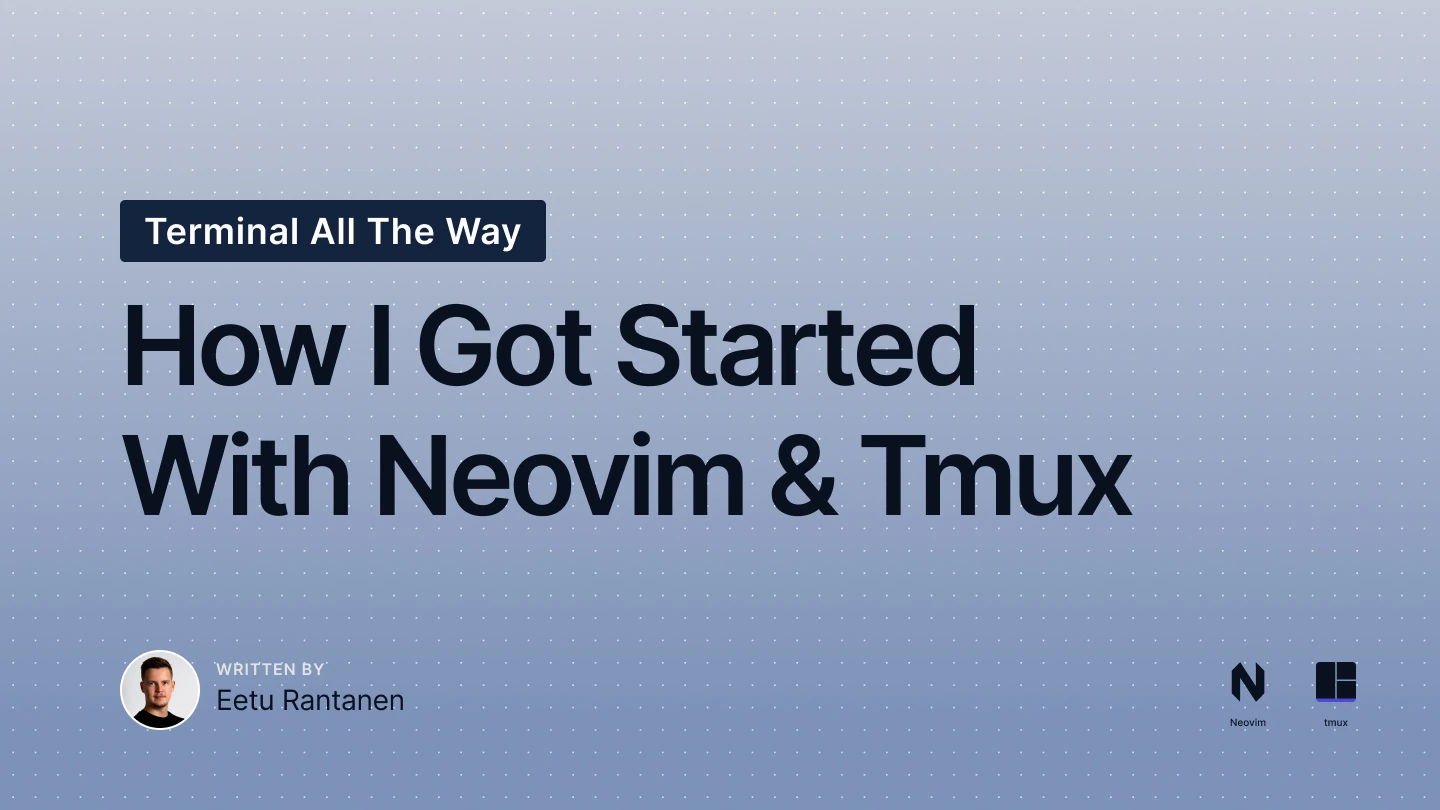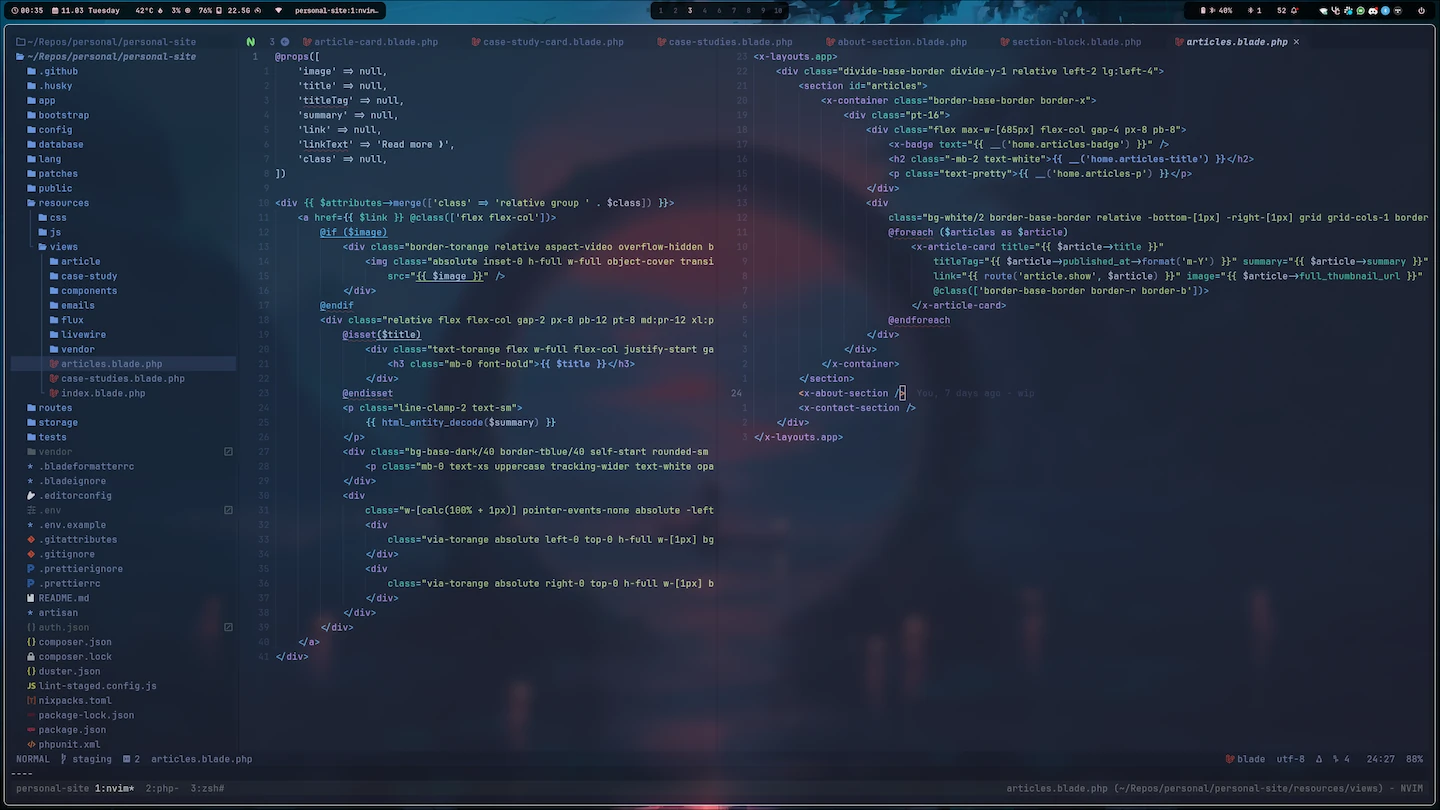
How I Got Started With Neovim and Tmux
After years using VS Code with its integrated terminal, I switched to Neovim and tmux. This article shares my journey, the challenges I faced, and why I'm sticking with this powerful combo.
Why I Wanted to Switch
My motivation for learning Neovim and tmux came from several directions:
-
Efficiency seeking: I wanted to be more productive in my coding workflow.
-
Terminal curiosity: I wanted to use and understand the terminal better.
-
Developer inspiration: I saw respected developers like Prime, Teej, DHH, and colleagues using and advocating for Neovim.
-
Microsoft concerns: I would rather not rely on their products, as I’m not a fan of their recent decisions.
My Neovim Journey
The False Start
Switching to Neovim was a long-considered decision. I wanted that experience after watching ThePrimeagen and Teej DeVries code in their matrix-like environment. It seemed satisfying and efficient.
When I first dual-booted with Linux (installed with Omakub), it came with preconfigured Neovim. I tried it for a few days but got frustrated with the slow speed and constant Vim keybinding lookup. So, I returned to VS Code.
The Real Commitment
During my second Linux installation with Hyprland, where neither VS Code nor Neovim was pre-installed, I decided to learn Neovim. To do this, I:
-
Binge-watch tutorials and configuration videos.
-
Read countless Neovim articles.
-
Fully understand the basics before installing it.
-
Follow the recommendation to install Neovim with kickstart.nvim
-
Read through the manual (being a well-commented init.lua file), trying every keybind to get a feel for it all.
I continued like this for a week until I felt comfortable enough to tweak the setup. Neovim is about molding the editor to your preferences and workflows.

My current Neovim & Tmux setup
Building My Setup
I found a helpful video that explained advanced concepts at a suitable pace with clear explanations. Using that as a guide, I wrote my own nvim configuration, installed useful plugins, and understood how they worked.
Since I write Laravel code in my free time, I discovered that getting a decent Laravel setup in Neovim requires quite a bit of configuration. Fortunately, I found Jess Archer's course on Laracasts about configuring Neovim for Laravel. This expanded my knowledge and gave me nice additions on top of the Laravel setup. Though the course is somewhat outdated, Jess maintains an open-source dotfiles repo with up-to-date configurations.
I'm now quite happy with my Neovim setup, though some issues remain. Blade files are still a pain to get working, and without a Laravel-specific language server, I can't configure it to match VS Code or PhpStorm for Laravel development. However, for JavaScript or TypeScript projects, the editor experience feels excellent.
Adding Tmux to the Mix
The Missing Integration
Coming from VS Code's integrated terminal, I missed that "integrated" feel in Neovim. For the first few weeks, I used a secondary terminal for running local servers or other development commands, but it didn't feel right.
I heard about the Neovim + tmux combo from the internet and colleagues, but didn't understand why until I realized it could provide the integrated experience I was looking for.
Learning and Configuring
I approached tmux like Neovim:
-
Researched extensively
-
Installed it
-
Configured it to my preferences
Now I've built enough muscle memory with both tools that I don't have to think about how to do what I need to do. I've integrated custom scripts to automate common tasks like:
-
Switching between projects
-
Opening pre-configured tmux panels when opening different projects
-
Fuzzy finding all repos with a simple tmux keybinding
Advice for Neovim and Tmux Beginners
Everyone learns tools differently, but here's what worked for me:
-
Find your motivation: I put off learning Neovim for years because I hadn't built a strong enough case for myself. Once I realized the lifelong benefits, I could push through the growing pains.
-
Research thoroughly: Understand the tools' functions and configuration options. You'll find details that make the tools just right for you.
-
Invest in proper learning: Understanding Neovim and tmux configurations makes you comfortable tweaking, adding plugins, or modifying functionality.
After this journey, I don't see myself returning to VS Code or other editors anytime soon. The terminal has won me over. Maybe this is just a phase, or maybe it's a life-long path. Only time will tell.